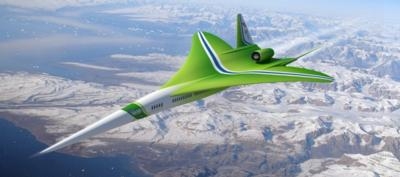Says Developments Would Reduce Sonic Booms 100 Fold Compared To Concorde
The future of air travel is bright – and fast, according to Lockheed Martin. Since the dawn of the jet age in the 1960s, commercial air travel has remained relatively unchanged. However, today’s demand for smarter and faster technologies is driving the next generation of commercial travel with supersonic aircraft, which could potentially cut U.S. coast-to-coast travel time almost in half.

With the commercial air travel industry expected to grow to more than five times its current size, the economic impact and significant time savings of a more efficient supersonic travel system will become increasingly important in our global economy.
One of the major hurdles of commercial supersonic air travel is the noise associated with it. At speeds greater than Mach 1, disturbances of air pressure around the airplane merge to form enormous shock waves resulting in sonic booms. For example, when you hear a car coming, you can hear it before it passes you because you hear increments of that sound continuously over a duration of time. In the case of a supersonic aircraft, you get all that sound over a very short duration of time causing a boom-like effect.
And sonic booms are very loud. Because of this, current air traffic regulations restrict supersonic planes from flying over land. Lockheed Martin says that for more than a decade it has been working to solve that problem. “To achieve revolutionary reductions in supersonic transportation airport noise, a totally new kind of propulsion system is being developed,” said Michael Buonanno, Lockheed Martin manager of the NASA N+2 program. “We are also exploring new techniques for low noise jet exhaust, integrated fan noise suppression, airframe noise suppression and computer customized airport noise abatement.”
Buonanno explained how over the years, his team has tackled several of these technology thrust areas. “We’ve developed a vehicle conceptual design and built a sub scale wind tunnel model to test the sonic boom characteristics that we predict will validate our ability to shape the airplane to generate much lower sonic boom levels.”
One of their breakthroughs was being able to develop the tools and codes that allow engineers and designers to accurately predict the loudness of a plane’s sonic boom. With the availability of these tools, a designer can develop an airplane concept that significantly reduces boom levels. Though it is not practical to completely eliminate noise, these advancements would result in a sonic boom that sounds much more like a distant thump rather than a sharp crack.
Lockheed Martin’s design would accommodate 80 passengers and have the ability to travel more than 5,000 nautical miles with sonic boom levels one hundred times quieter than the now-retired Concorde supersonic passenger airline. The Concorde was first flown in 1969 and was one of only two supersonic passenger airliners to have entered commercial service.
How would it work? “It’s all about the design details,” said Buonanno. “You need to able to manage the progress of volume and lift to create series of closely timed small shocks rather than one big one. Our testing has given us the confidence we need to have a good understanding of how sonic boom levels work and how to design airplanes to meet the required boom levels.”
The aircraft would have to be very long, so that the volume and the lift of the plane are allowed to gradually build up and then decrease. The engine is also extremely important. Under the N+2 program, Lockheed Martin has worked with General Electric and Rolls Royce to look at engine concepts that have high fuel efficiency and can meet the takeoff and landing noise constraints. “The engine itself does not contribute to a sonic boom but you have to have a good integration of the engine into the airframe,” said Buonanno.
Lockheed Martin’s N+2 concept has a tri-jet configuration; one engine is on the top of the aircraft and the other two are located under each wing. Though not physically hidden, these locations are essentially concealed from the sonic boom because of the tailored volume and lift distribution of the plane. Therefore, the disturbance simply blends in.
And while passengers won’t be buying tickets for these aircraft in the next five years, Buonanno estimates the technology will be ready around the 2025 timeframe. “We calculate that timeframe by gauging the technology readiness levels,” said Buonanno. He explained that one of the pacing items would be the availability of a propulsion system. “Having something that’s efficient at high speeds and quiet is a big technical challenge.”
By choosing Mach 1.7 design, the team has been able to significantly simplify the problem of developing a propulsion system that’s compatible with low emissions and takeoff and landing noise. Although slightly slower than Concorde’s Mach 2 cruise speed, this enables the use of higher bypass ratio engines for lower takeoff noise and would still permit approximately a 50 percent reduction of trip time compared to today’s aircraft. “Our work with NASA has laid the groundwork for any future activity,” said Buonanno. The tools we’ve put in place really open up future opportunities.”
(Image provided by Lockheed Martin)
 Airborne 11.05.25: Tesla Flying Car?, Jepp/ForeFlight Sold, A220 Troubles
Airborne 11.05.25: Tesla Flying Car?, Jepp/ForeFlight Sold, A220 Troubles Airborne 11.07.25: Affordable Expo Starts!, Duffy Worries, Isaacman!
Airborne 11.07.25: Affordable Expo Starts!, Duffy Worries, Isaacman! Aero-News: Quote of the Day (11.05.25)
Aero-News: Quote of the Day (11.05.25) ANN's Daily Aero-Linx (11.05.25)
ANN's Daily Aero-Linx (11.05.25) NTSB Prelim: Cirrus Design Corp SR22
NTSB Prelim: Cirrus Design Corp SR22



